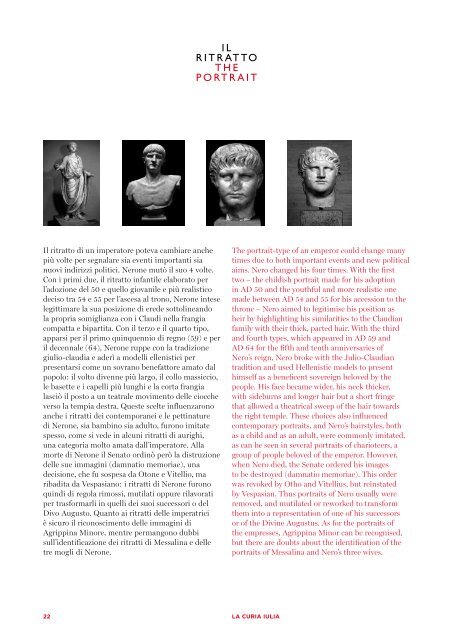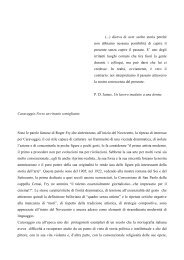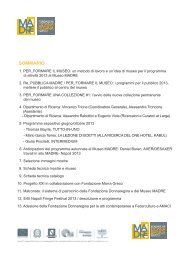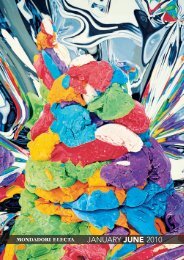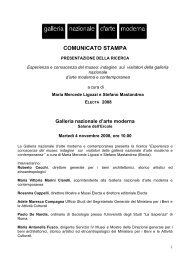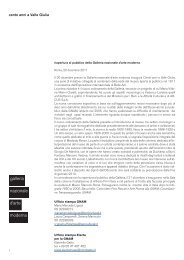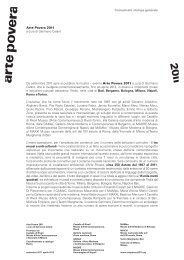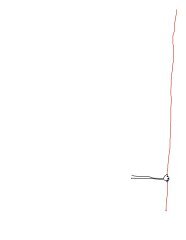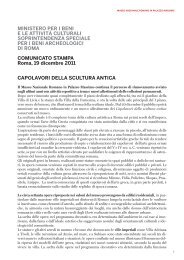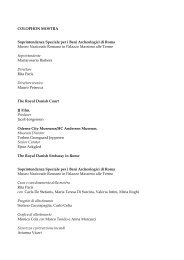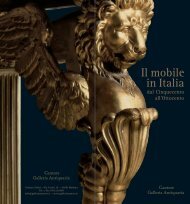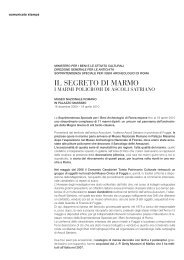You also want an ePaper? Increase the reach of your titles
YUMPU automatically turns print PDFs into web optimized ePapers that Google loves.
Il ritratto di un imperatore poteva cambiare anche<br />
più volte per segnalare sia eventi importanti sia<br />
nuovi indirizzi politici. <strong>Nerone</strong> mutò il suo 4 volte.<br />
Con i primi due, il ritratto infantile elaborato per<br />
l’adozione del 50 e quello giovanile e più realistico<br />
deciso tra 54 e 55 per l’ascesa al trono, <strong>Nerone</strong> intese<br />
legittimare la sua posizione di erede sottolineando<br />
la propria somiglianza con i Claudi nella frangia<br />
compatta e bipartita. Con il terzo e il quarto tipo,<br />
apparsi per il primo quinquennio di regno (59) e per<br />
il decennale (64), <strong>Nerone</strong> ruppe con la tradizione<br />
giulio-claudia e aderì a modelli ellenistici per<br />
presentarsi come un sovrano benefattore amato dal<br />
popolo: il volto divenne più largo, il collo massiccio,<br />
le basette e i capelli più lunghi e la corta frangia<br />
lasciò il posto a un teatrale movimento delle ciocche<br />
verso la tempia destra. Queste scelte influenzarono<br />
anche i ritratti dei contemporanei e le pettinature<br />
di <strong>Nerone</strong>, sia bambino sia adulto, furono imitate<br />
spesso, come si vede in alcuni ritratti di aurighi,<br />
una categoria molto amata dall’imperatore. Alla<br />
morte di <strong>Nerone</strong> il Senato ordinò però la distruzione<br />
delle sue immagini (damnatio memoriae), una<br />
decisione, che fu sospesa da Otone e Vitellio, ma<br />
ribadita da Vespasiano: i ritratti di <strong>Nerone</strong> furono<br />
quindi di regola rimossi, mutilati oppure rilavorati<br />
per trasformarli in quelli dei suoi successori o del<br />
Divo Augusto. Quanto ai ritratti delle imperatrici<br />
è sicuro il riconoscimento delle immagini di<br />
Agrippina Minore, mentre permangono dubbi<br />
sull’identificazione dei ritratti di Messalina e delle<br />
tre mogli di <strong>Nerone</strong>.<br />
I L<br />
R I T R AT TO<br />
T H E<br />
P O RT R A I T<br />
22 LA CURIA IULIA<br />
The portrait-type of an emperor could change many<br />
times due to both important events and new political<br />
aims. Nero changed his four times. With the first<br />
two – the childish portrait made for his adoption<br />
in AD 50 and the youthful and more realistic one<br />
made between AD 54 and 55 for his accession to the<br />
throne – Nero aimed to legitimise his position as<br />
heir by highlighting his similarities to the Claudian<br />
family with their thick, parted hair. With the third<br />
and fourth types, which appeared in AD 59 and<br />
AD 64 for the fifth and tenth anniversaries of<br />
Nero’s reign, Nero broke with the Julio-Claudian<br />
tradition and used Hellenistic models to present<br />
himself as a beneficent sovereign beloved by the<br />
people. His face became wider, his neck thicker,<br />
with sideburns and longer hair but a short fringe<br />
that allowed a theatrical sweep of the hair towards<br />
the right temple. These choices also influenced<br />
contemporary portraits, and Nero’s hairstyles, both<br />
as a child and as an adult, were commonly imitated,<br />
as can be seen in several portraits of charioteers, a<br />
group of people beloved of the emperor. However,<br />
when Nero died, the Senate ordered his images<br />
to be destroyed (damnatio memoriae). This order<br />
was revoked by Otho and Vitellius, but reinstated<br />
by Vespasian. Thus portraits of Nero usually were<br />
removed, and mutilated or reworked to transform<br />
them into a representation of one of his successors<br />
or of the Divine Augustus. As for the portraits of<br />
the empresses, Agrippina Minor can be recognised,<br />
but there are doubts about the identification of the<br />
portraits of Messalina and Nero’s three wives.


